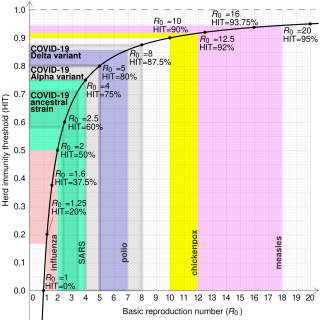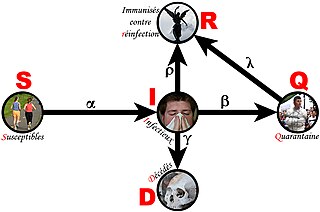Related Research Articles

Epidemiology is the study and analysis of the distribution, patterns and determinants of health and disease conditions in a defined population.
The science of epidemiology has matured significantly from the times of Hippocrates, Semmelweis and John Snow. The techniques for gathering and analyzing epidemiological data vary depending on the type of disease being monitored but each study will have overarching similarities.
A cohort study is a particular form of longitudinal study that samples a cohort, performing a cross-section at intervals through time. It is a type of panel study where the individuals in the panel share a common characteristic.
Sensitivity analysis is the study of how the uncertainty in the output of a mathematical model or system can be divided and allocated to different sources of uncertainty in its inputs. A related practice is uncertainty analysis, which has a greater focus on uncertainty quantification and propagation of uncertainty; ideally, uncertainty and sensitivity analysis should be run in tandem.

A case–control study is a type of observational study in which two existing groups differing in outcome are identified and compared on the basis of some supposed causal attribute. Case–control studies are often used to identify factors that may contribute to a medical condition by comparing subjects who have that condition/disease with patients who do not have the condition/disease but are otherwise similar. They require fewer resources but provide less evidence for causal inference than a randomized controlled trial. A case–control study is often used to produce an odds ratio, which is an inferior measure of strength of association compared to relative risk, but new statistical methods make it possible to use a case-control study to estimate relative risk, risk differences, and other quantities.

In epidemiology, the basic reproduction number, or basic reproductive number, denoted , of an infection is the expected number of cases directly generated by one case in a population where all individuals are susceptible to infection. The definition assumes that no other individuals are infected or immunized. Some definitions, such as that of the Australian Department of Health, add the absence of "any deliberate intervention in disease transmission". The basic reproduction number is not necessarily the same as the effective reproduction number , which is the number of cases generated in the current state of a population, which does not have to be the uninfected state. is a dimensionless number and not a time rate, which would have units of time−1, or units of time like doubling time.
Mathematical models can project how infectious diseases progress to show the likely outcome of an epidemic and help inform public health and plant health interventions. Models use basic assumptions or collected statistics along with mathematics to find parameters for various infectious diseases and use those parameters to calculate the effects of different interventions, like mass vaccination programs. The modelling can help decide which intervention(s) to avoid and which to trial, or can predict future growth patterns, etc.

In causal inference, a confounder is a variable that influences both the dependent variable and independent variable, causing a spurious association. Confounding is a causal concept, and as such, cannot be described in terms of correlations or associations. The existence of confounders is an important quantitative explanation why correlation does not imply causation. Some notations are explicitly designed to identify the existence, possible existence, or non-existence of confounders in causal relationships between elements of a system.

In the philosophy of science, a causal model is a conceptual model that describes the causal mechanisms of a system. Several types of causal notation may be used in the development of a causal model. Causal models can improve study designs by providing clear rules for deciding which independent variables need to be included/controlled for.

In statistics, a mediation model seeks to identify and explain the mechanism or process that underlies an observed relationship between an independent variable and a dependent variable via the inclusion of a third hypothetical variable, known as a mediator variable. Rather than a direct causal relationship between the independent variable and the dependent variable, a mediation model proposes that the independent variable influences the mediator variable, which in turn influences the dependent variable. Thus, the mediator variable serves to clarify the nature of the relationship between the independent and dependent variables.

In epidemiology, Mendelian randomization is a method using measured variation in genes to interrogate the causal effect of an exposure on an outcome. Under key assumptions, the design reduces both reverse causation and confounding, which often substantially impede or mislead the interpretation of results from epidemiological studies.
Economic epidemiology is a field at the intersection of epidemiology and economics. Its premise is to incorporate incentives for healthy behavior and their attendant behavioral responses into an epidemiological context to better understand how diseases are transmitted. This framework should help improve policy responses to epidemic diseases by giving policymakers and health-care providers clear tools for thinking about how certain actions can influence the spread of disease transmission.
The Bradford Hill criteria, otherwise known as Hill's criteria for causation, are a group of nine principles that can be useful in establishing epidemiologic evidence of a causal relationship between a presumed cause and an observed effect and have been widely used in public health research. They were established in 1965 by the English epidemiologist Sir Austin Bradford Hill.
Cause, also known as etiology and aetiology, is the reason or origination of something.
Causal inference is the process of determining the independent, actual effect of a particular phenomenon that is a component of a larger system. The main difference between causal inference and inference of association is that causal inference analyzes the response of an effect variable when a cause of the effect variable is changed. The science of why things occur is called etiology, and can be described using the language of scientific causal notation. Causal inference is said to provide the evidence of causality theorized by causal reasoning.

The discipline of forensic epidemiology (FE) is a hybrid of principles and practices common to both forensic medicine and epidemiology. FE is directed at filling the gap between clinical judgment and epidemiologic data for determinations of causality in civil lawsuits and criminal prosecution and defense.

Neil Morris Ferguson is a British epidemiologist and professor of mathematical biology, who specialises in the patterns of spread of infectious disease in humans and animals. He is the director of the Jameel Institute, and of the MRC Centre for Global Infectious Disease Analysis, and head of the Department of Infectious Disease Epidemiology in the School of Public Health and Vice-Dean for Academic Development in the Faculty of Medicine, all at Imperial College London.
CovidSim is an epidemiological model for COVID-19 developed by Imperial College COVID-19 Response Team, led by Neil Ferguson. The Imperial College study addresses the question: If complete suppression is not feasible, what is the best strategy combining incomplete suppression and control that is feasible and leads to acceptable outcomes?

Andrea Saltelli is an Italian scholar studying quantification with statistical and sociological tools, extending the theory of sensitivity analysis to sensitivity auditing.
In the field of epidemiology, source attribution refers to a category of methods with the objective of reconstructing the transmission of an infectious disease from a specific source, such as a population, individual, or location. For example, source attribution methods may be used to trace the origin of a new pathogen that recently crossed from another host species into humans, or from one geographic region to another. It may be used to determine the common source of an outbreak of a foodborne infectious disease, such as a contaminated water supply. Finally, source attribution may be used to estimate the probability that an infection was transmitted from one specific individual to another, i.e., "who infected whom".
References
- ↑ Saltelli, A. (2002). "Sensitivity Analysis for Importance Assessment". Risk Analysis. 22 (3): 1–12. CiteSeerX 10.1.1.194.7359 . doi:10.1111/0272-4332.00040. PMID 12088235. S2CID 62191596.
- ↑ Saltelli, A.; Ratto, M.; Andres, T.; Campolongo, F.; Cariboni, J.; Gatelli, D.; Saisana, M.; Tarantola, S. (2008). Global Sensitivity Analysis: The Primer. John Wiley & Sons.
- 1 2 Ding, Peng; VanderWeele, Tyler J., 2016, Sensitivity Analysis Without Assumptions, Epidemiology, Volume 27 - Issue 3 - p 368-377
- 1 2 Saltelli, A.; Bammer, G.; Bruno, I.; Charters, E.; Di Fiore, M.; Didier, E.; Espeland Nelson, W.; Kay, J.; Lo Piano, S.; Mayo, D.; Pielke Jr, R.; Portaluri, T.; Porter, T.M.; Puy, A.; Rafols, I.; Ravetz, J.R.; Reinert, E.; Sarewitz, D.; Stark, P.B.; Stirling, A.; van der Sluijs, J.; Vineis, P. (2020). "Five ways to ensure that models serve society: a manifesto". Nature. 582 (7813): 482–484. Bibcode:2020Natur.582..482S. doi: 10.1038/d41586-020-01812-9 . hdl: 1885/219031 . PMID 32581374.
- ↑ Joseph AC Delaney, John D Seeger, 2013, Chapter 11, Sensitivity Analysis, in Developing a Protocol for Observational Comparative Effectiveness Research: A User's Guide, Velentgas P, Dreyer NA, Nourjah P, et al., editors, Agency for Healthcare Research and Quality (US); Publication No.: 12(13)-EHC099.
- ↑ Arino, J.; Portet, S. (2020). "A simple model for COVID-19". Infectious Disease Modelling. 5: 309–315. doi: 10.1016/j.idm.2020.04.002 . PMC 7186130 . PMID 32346663.
- ↑ Borgonovo, E.; Lu, X. (2020). "Is Time to Intervention in the COVID-19 Outbreak Really Important? A Global Sensitivity Analysis Approach". arXiv: 2005.01833 [stat.AP].